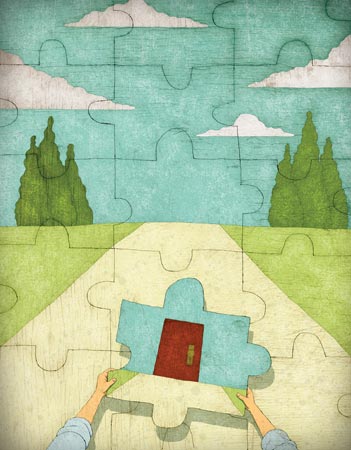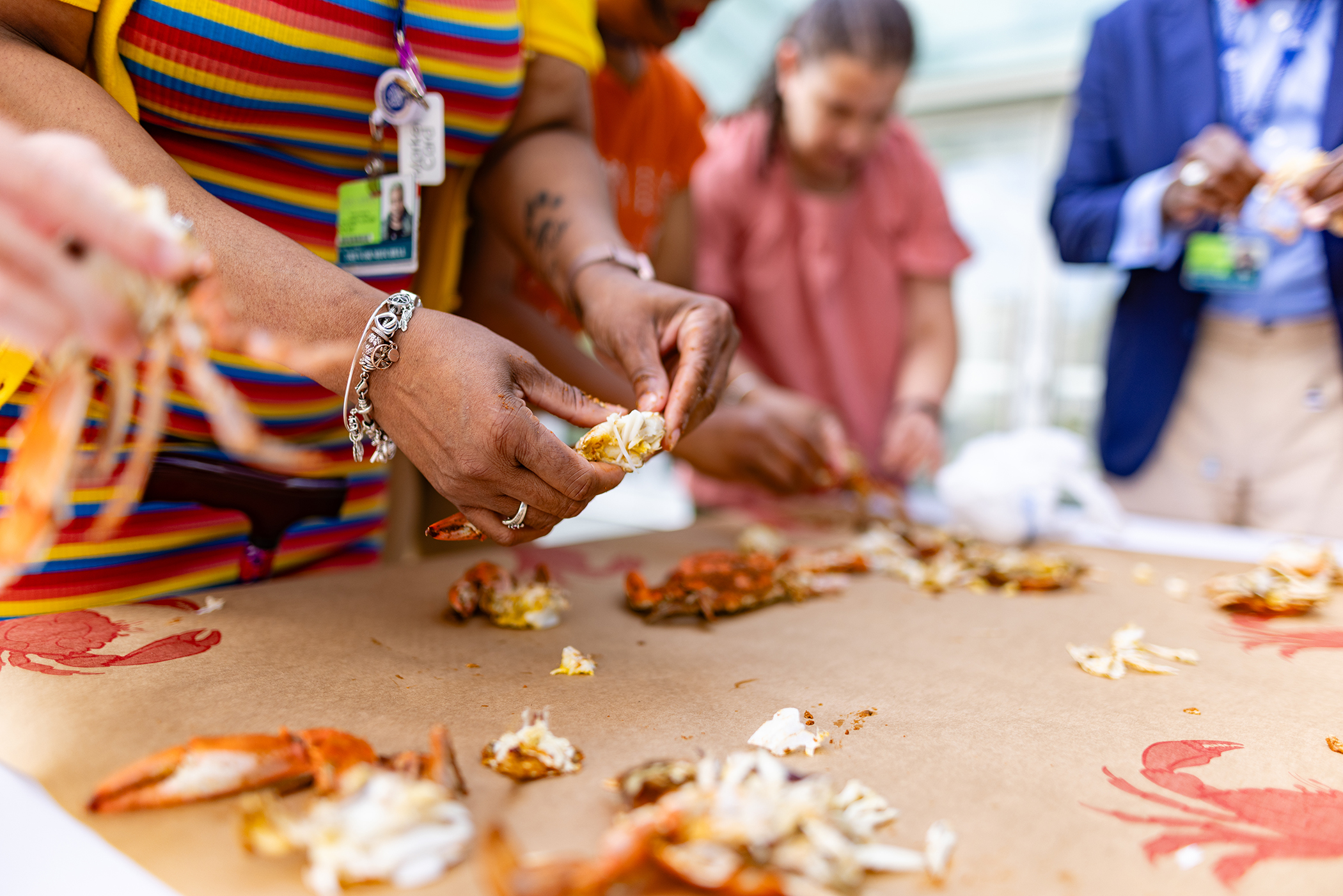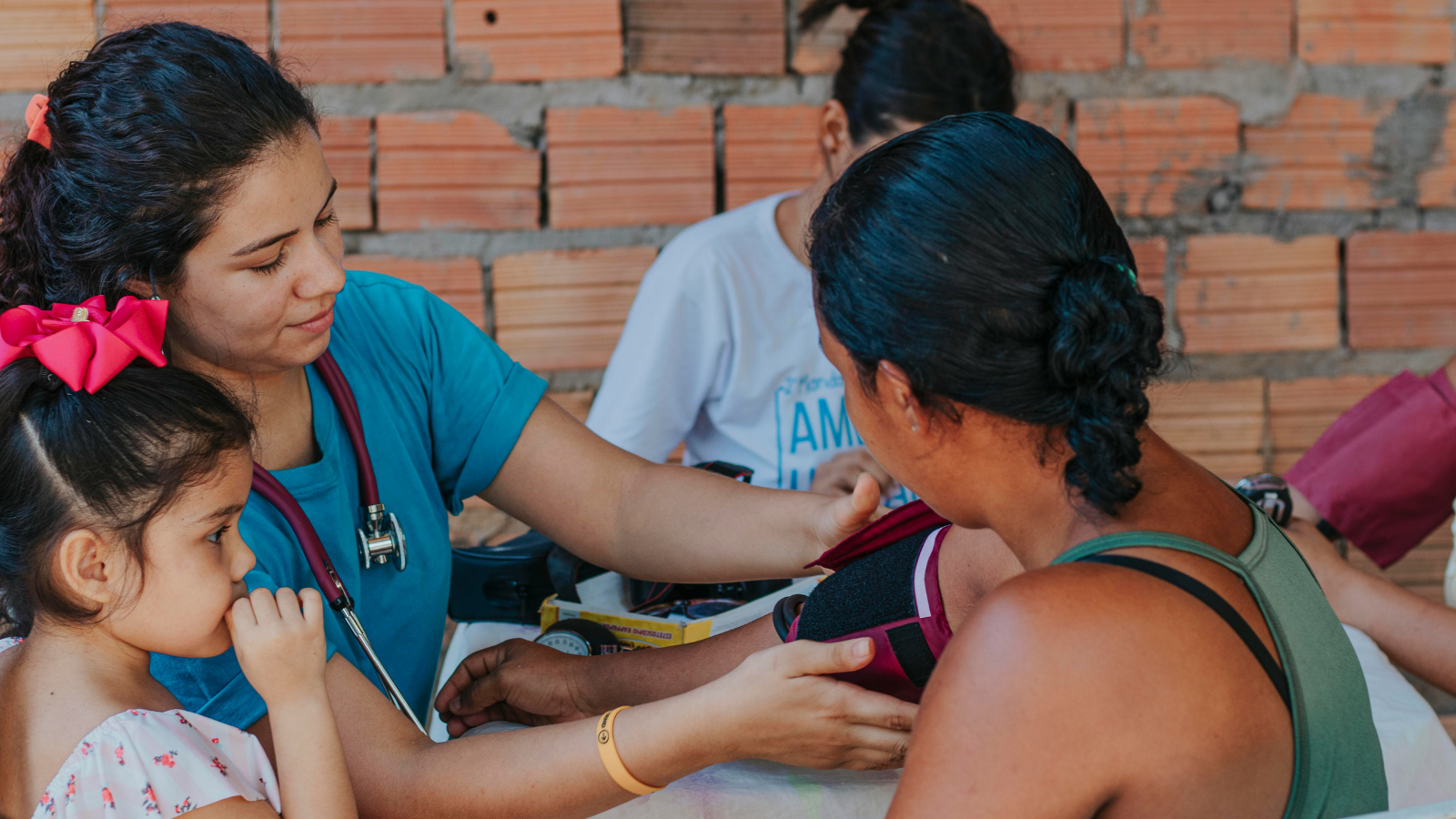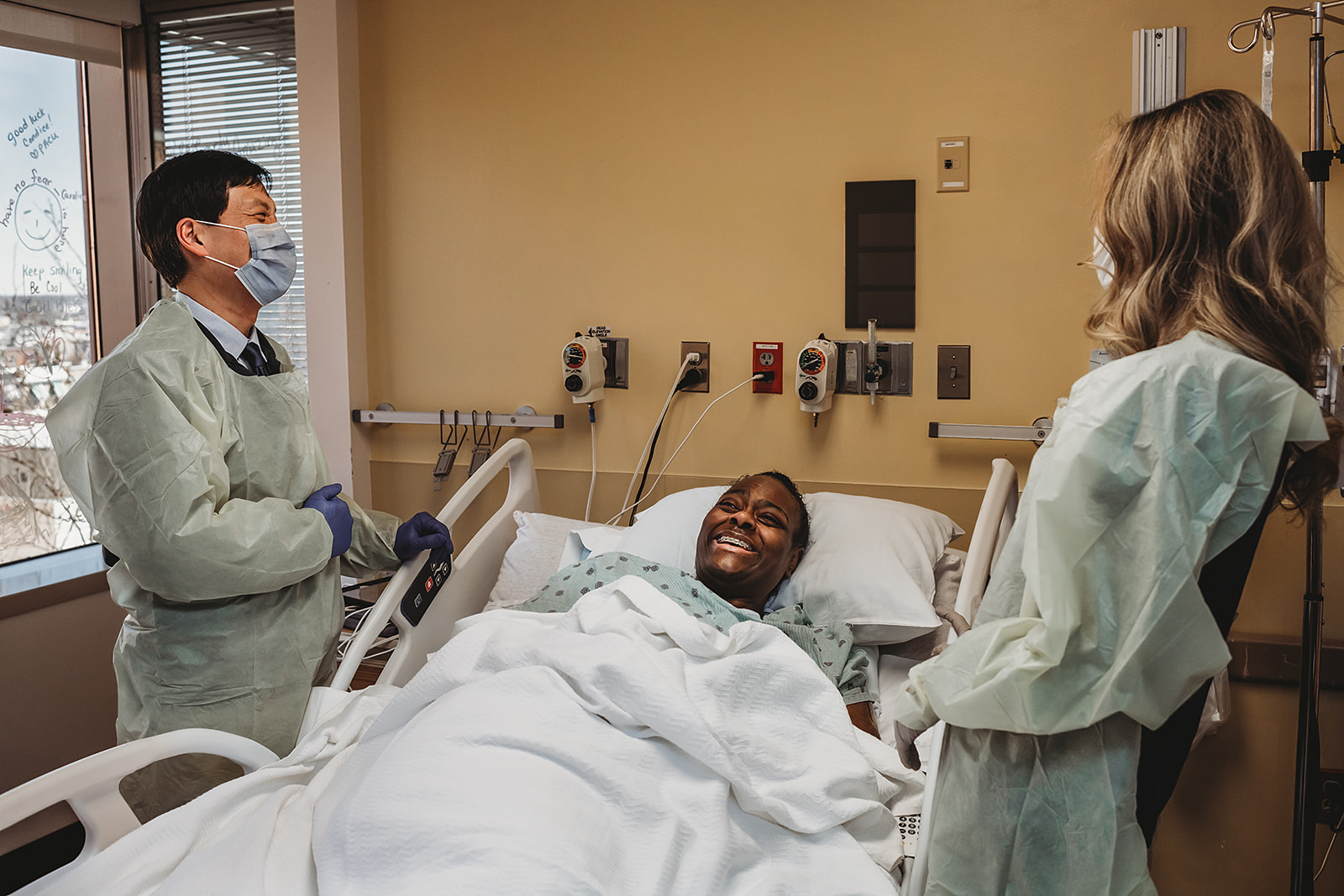 Exploring uncharted territory, researchers are blazing a path to better nursing practice.
Exploring uncharted territory, researchers are blazing a path to better nursing practice.
By Geoff Brown
Illustration by Jesse Kuhn
Fridays were not the easiest days for research at one particular South African hospital, explains School of Nursing PhD student Carrie Tudor, MPH, BS ’08, RN. That’s because Friday was the day when the patients in the drug-resistant tuberculosis (TB) ward would most likely riot.
In fact, over this past summer, Tudor and other researchers from Johns Hopkins were chased out of the hospital by disgruntled TB patients. “They liked to riot on Fridays,” says Tudor, ‘because that would put the hospital in lockdown, and that would get the staff locked in for the whole weekend.”
The riots are a kind of payback from the patients for their own treatment: government policy dictates that patients with drug-resistant TB be locked away for anywhere from six months to two years, until they’re deemed no longer infectious. Armed security guards keep the patients in poorly maintained areas; the rioting is an attempt to get better treatment and secure basic rights, and the presence of outside healthcare workers adds to the tension.
For Tudor, whose 10-year career in public health research has taken her from Myanmar to Tibet, the experience was a new one, but it reinforced the importance of the research she’s performing in her new role as a nurse. She and colleagues are visiting 24 South African drug-resistant TB hospitals to find ways to protect healthcare workers from contracting the disease.
“I had originally been looking at doing research in China,” she says, “but when I got the opportunity to travel to South Africa with my adviser [Assistant professor Jason Farley, PhD, MPH, CRNP], I took it. Now that I’ve been there, I feel very strongly about helping the patients and healthcare workers there any way I can.”
Research with Reach
Tudor’s dissertation work – finding out how to protect healthcare workers from the drug-resistant infectious disease they’re trying to help cure – is a perfect example of the primary focus of nursing research: People. “Nursing research takes the lead in focusing on the individual, while our interventions may be at the individual, community, or system level,” says associate dean for research Jerilyn Allen, ScD, RN, FAAN.
Nursing research has grown to fill a gap that was developing as other fields began to specialize and expand into specific areas of discovery. Medical researchers perform laboratory (“bench”) work and study the interaction of drugs and treatments with people (“bedside”); public health looks at the conditions of populations, be it a few dozen or an entire race. Where nursing research has blossomed is in reconnecting the patient and the healthcare provider with the findings made across the healthcare spectrum.
Medical technology and instrumentation have made incredible strides in the past decade, providing caregivers with volumes of data on the physical status of patients. What patients haven’t been able to express as well to physicians and nurses are less tangible conditions, like pain or the threat of ongoing domestic violence. So what nurse researchers at Johns Hopkins have done is develop ingenious tools that reliably and scientifically measure these factors.
Two well-known examples to come out of Hopkins nursing research are the Pain-O-Meter and the Danger Assessment tool. The Pain-O-Meter, developed by professor Fannie Gaston-Johansson, PhD, RN, FAAN, is a simple, reusable eight-inch plastic wand that looks a bit like a wide ruler. The device’s tabs, diagrams, and sliding markers help patients translate what kind of pain they’re feeling – sharp, dull, throbbing, waning – and where they’re feeling it.
The Pain-O-Meter lets patients provide clear visual benchmarks that help nurses and other healthcare workers understand and track the patient’s pain, and gives them a better chance to help ease it. Gaston-Johansson developed the patented device in the early 1990s in response to the growing concern about inadequate pain management and treatment, and it has now been successfully used in the U.S. and Sweden for decades.
It’s a perfect example of the wisdom and ingenuity of nursing research: after seeing patients and providers having difficulty communicating about pain management, a nurse researcher created a device that allows the patient to quickly and clearly express his or her situation, which better guides treatment, and then allows for immediate re-evaluation by the patient. “Nurses look at things that are important not just to patients and families,” says Dean Hill, “but to other members of the healthcare team.”
The Danger Assessment tool is not a physical device like the Pain-O-Meter: it’s a series of questions. But those questions are also effective in getting the patient to communicate crucial information to nurses and healthcare providers, and it can save lives. Created by associate dean Jacquelyn Campbell, PhD, RN, FAAN, the Danger Assessment is presented to victims of domestic and intimate partner violence; after determining the frequency and severity of abuse, the Danger Assessment poses 20 questions that help both nurses and patients get a clear picture of the facts and situation. That assessment guides better treatment decisions, and it also gives patients a new perspective on their risk level that can lead to them entering a shelter or seeking legal protection.
“The School of Nursing has led the way in developing evidence for when to do specific things in clinical practice,” says Nancy Glass, PhD, MPH, RN, FAAN, who works with victims of domestic and partner violence in the U.S. and Africa. It’s that specificity that can make all the difference. “We now ask four questions of a patient, and they are not ‘Have you been abused?’ but rather specific items such as, ‘Have you been hit, slapped, punched, choked, or otherwise physically hurt?’ From there, if the answers warrant, we’ll use the Danger Assessment tool to ask more questions. Asking questions can literally save a woman’s life.”
“Nurses definitely lead the way in advocating for self-care management to promote health and prevent disease,” says Allen. “Empowering the patient is something unique to the nursing profession.”
Focus on the Future
The School of Nursing’s PhD program stresses three things, according to Marie Nolan, PhD, MPH, RN, FAAN, and director of the program. First is creating a tight connection between a student and a faculty member with a sustained program of research and that means maintaining a low student-to-advisor ratio. “Our students are in a closely mentored relationship with a funded researcher, and our faculty have only two to five student advisees each,” says Nolan.
That kind of close relationship, and exposure to the innovations and discoveries of Johns Hopkins nurse researcher pioneers, creates “a ripple effect,” says Dean Hill. “It gets more students saying, ‘I want to do what she’s doing.'”
Today’s students are also looking for a different experience than that of their professors. “We want to immerse students into the community of learning,” says associate dean Pamela Jeffries, DNS, RN, FAAN, ANEF. “We want students to feel like they belong to the unit. This is a different generation of learners – they’re high-energy, high-expectation, and not passive. We have to engage them. They like experiential, real-life learning. They’re poised, goal-directed, and they keep the faculty on their toes.”
The second mission is to take advantage of interdisciplinary collaboration and research, which teams Johns Hopkins School of Nursing researchers with counterparts from the School of Medicine and the Bloomberg School of Public Health. “Our collaborations are made easier by our location. ItÕs as easy as walking across the street to medicine or public health and saying, ‘I need an expert in quality of life measurement for a study,'” says Nolan.
Nursing research has earned its place through sound scientific method and persistence. “By doing so well for so long, I think we’ve gained respect and a very good reputation,” says Miyong Kim, PhD, RN, FAAN. “You need to have a nurse on your team.”
Professor Gayle Page DNSc, RN, FAAN has been working with Jennifer Haythornthwaite, PhD, a clinical psychologist from the School of Medicine for more than seven years on pain research. The project began with a post-doctoral student of Haythornwaite’s who wanted to learn more about biometric outcomes, an area of Page’s research. “Now, we’re collaborating on each other’s grants,” Page says, and they are co-directors of the Hopkins Interdisciplinary Training Program in Biobehavioral Pain Research, a postdoctoral, interdisciplinary training program.
“The NIH and healthcare in general are asking for a broader approach,” Page explains, “and that means research needs to be done as more of a team effort. Pain research is very amenable to that approach. Jennifer is a psychologist, and I’m a nurse and a neuroscientist, which makes our approaches really complementary.”
The final strategy in PhD education is to encourage faculty and staff to look beyond Baltimore and the U.S. “We have not just a national focus, but a global one as well,” explains Nolan – one that sends doctoral students like Tudor to South Africa, or Sara Rosenthal to Berlin, Germany.
“I was asked to present my research at a university in Berlin,” Nolan recalls, “and I said, ‘I have a doctoral student [Rosenthal] doing research on how parents make decisions about their critically ill infants in the NICU. She speaks German. Would you be interested in having her present as well?’ And they said absolutely, bring her, and now she’s also giving a presentation.”
Associate professor Nancy Glass, PhD, MPH, RN, FAAN, whose current work researching intimate partner violence (IPV) takes her from Oregon to Baltimore and to the Congo and Uganda, says she has “the best job in the world.”
“The School of Nursing has evolved over time,” says Glass. “I left Johns Hopkins for five years to do work in Oregon, but I came back because of the growing focus on global health. For students and faculty to now have the opportunity to do clinical work in Haiti or Uganda shows how the school’s commitment has evolved. I never minded getting on a plane. Working on violence against women is not easy work. You have to be there, and be face-to-face as much as you can.’
Choosing the Right Route
As she prepares to head back to South Africa for another month of study and training hospital healthcare workers, Carrie Tudor says she knows she made the right choice by becoming a nurse. “Coming from public health, nursing was the right route for me. Nursing and public health are very similar – they both look at people who are often overlooked, and things that sometimes get missed. Being on the ground is the only way to go. You can’t fly in, look at it, and walk away. You need to be in the hospitals and clinics, building relationships.
“And when I go into hospitals and clinics now, I can tell nurses there that I’m a nurse too,” Tudor explains, “and they say, ‘Oh, okay. You’re one of us.'”
Funding for the Future
Philanthropists encourage funding of doctoral nursing education
By Kelly Brooks-Staub
“There’s something special about the nursing profession,” says philanthropist Donald Jonas. “You can’t write it up. It’s the people, the kindness, the relationship with your fellow workers. It touches me every time.”
Donald Jonas and his wife, Barbara, are avid supporters of doctoral nursing education, and they’re encouraging others to donate to the cause as well. Last October, the Jonas duo gathered philanthropists, doctoral students, faculty, and administrators at the Johns Hopkins University School of Nursing to discuss the need for doctoral education funding.
Karen Haller, PhD, RN, FAAN, vice president for nursing and patient care services at The Johns Hopkins Hospital, opened the session with an irrefutable argument for PhD-level nursing education: “One of the key reasons for the nursing shortage – predicted to be 500,000 nurses by 2025 – is that we’re lacking faculty to train the next generation of nurses and nurse leaders. To solve the nursing shortage, we need more doctoral nursing education.”
The Jonas Center for Nursing Excellence Nursing Scholars Program, funded by Donald and Barbara Jonas, provides tuition grants and living stipends for PhD students who aspire to become nurse educators. Jan Kaminsky, BSN, a pre-doctoral fellow at JHUSON, is a current Jonas Scholar and plans to teach on a nursing faculty in New York City.
“We’re a small foundation,” said Jonas, “but we have enormous ambition and drive to make some good happen while we’re still around. We hope others will do the same.”
 Forging Policy: How Can Doulas Improve Black Maternal Health?
Forging Policy: How Can Doulas Improve Black Maternal Health? My First Teachers in Nursing School Weren’t Nurses
My First Teachers in Nursing School Weren’t Nurses JHSON Highlights
JHSON Highlights What Works: Community-Led Research Promotes Evidence-Based Strategies to Improve Indigenous Health by Championing Indigenous Nursing Practice
What Works: Community-Led Research Promotes Evidence-Based Strategies to Improve Indigenous Health by Championing Indigenous Nursing Practice ‘Helpful, Powerful, Kind’ Palliative Care
‘Helpful, Powerful, Kind’ Palliative Care






